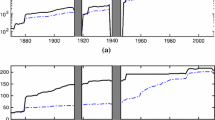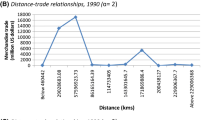Abstract
This paper finds the first empirical evidence of the time zone-related continuity effects on international trade. Several recent studies in the fragmentation/distance literatures provide theoretical justification for both positive (continuity) and negative (synchronization) effects of increased time zone differences on global export flows. This paper explicitly tests for the presence of both effects using bilateral manufacturing and service trade for 20 countries and 56 partner countries from 2000 to 2008. Results consistent with the theoretical expectations are found using a Poisson pseudo-maximum likelihood estimator. The general time zone difference effect on total exports is negative, suggesting the synchronization effect dominates. However, for services trade, the positive continuity effect is noted, indicating that time zones affect manufacturing and service trades differently. These results are robust to changes in the time zone, distance, and language measures, as well as alternate estimation techniques.


Similar content being viewed by others
Notes
Head et al. (2009) are also puzzled by these goods results. They do not suggest a reason for this disconnect between the empirical results and the theoretical expectations.
This is the problem suffered in Christen (2011) which uses the United States as the only source country. This leads to problems such as not having any countries with a 3 or 4 h time zone difference.
Note that that flow values reported as “0” are included in the data set, as I am able to distinguish between ‘missing’ and ‘no export’ data.
UTC stands for Coordinated Universal Time and is standard time zone measure that ranges from −12 to +14. Differences in time zones can be found by subtracting one UTC from the other. Here, 12 to −6 yields the 18 h difference.
Great circle distance is the shortest distance between two points along a sphere. Distance enters in log form because standard gravity literature states that the level of trade is directly proportional to mass (measured as GDP) and inversely related to distance which can be expressed as: Trade = MiMj/Dij. To separate out the different effects, logs are taken to give: ln(trade) = ln(Mi) + ln(Mj) − ln(Dij).
In this case, the net effect of time zones on goods exports is σ, while the net effect of time zones on services exports is σ + δ.
The expected signs in this case are the reverse of the expected signs for the time zones effect above. A large time zone difference is equivalent to a small (or zero) amount of overlap hours.
Following Stein and Daude (2007), for the United States, the more centrally located Chicago was used over Washington, DC.
For the United States, only time zones in the contiguous 48 states were considered.
The 2000 Eurobarometer Special Survey finds that 88% of Swedish citizens speak English very well. Other Scandinavian countries also have very large English-speaking populations. For instance, the Finnish newspaper Helsingin Sanomat (September 9, 2003) notes that “Finland has shifted from being a Finnish-speaking industrial economy to an English-language financial economy.” Previous studies have also made this adjustment (e.g., Gross and Ryan 2008).
To avoid losing the zero observations when taking logs, I use the log(1 + exports) to proxy for log(exports).
The p-value on the test of σs – σg = 0 is 0.02 suggesting that the two coefficients are significantly different from each other.
For India and Venezuela, where time zone differences are not integers, they were rounded up (so a time zone difference of 2.5 is counted as a time zone difference of 3 for this section). Time zone differences of eleven and twelve are combined due to the small number of country pairs with a time zone difference of 12 for goods exports, while time zone differences of 10–12 h are counted together for service exports.
References
Athukorala, P., & Yamashita, N. (2008). Global production sharing and US-China trade relations (Departmental Working Papers 2008–22). Australian National University, Arndt-Corden Department of Economics.
Christen, E. (2011). Time zones matter: The impact of distance and timezones on service trade (Working paper 1210). Department of Economics, Johannes Kepler University of Linz.
Daude, C., Levy-Yeyati, E., & Stein, E. (2003). Regional Integration and the Location of FDI (Working paper 492). Research Department, Inter-American Development Bank, Washington, DC.
Egger, P., & Pfaffermayr, M. (2004). The impact of bilateral investment treaties on foreign direct investment. Journal of Comparative Economics, 32, 788–804.
Gross, D., & Ryan, M. (2008). FDI location and size: Does employment protection legislation matter? Regional Science and Urban Economics, 38(6), 590–605.
Hattari, R., & Rajan, R. S. (2008). Sources of FDI flows to developing Asia: The roles of distance and time zones (ADBI Working Paper 117). Tokyo: Asian Development Bank Institute.
Head, K. (2003). Gravity for beginners, Mimeo. Vancouver: Faculty of Commerce, University of British Columbia.
Head, K., Mayer, T., & Ries, J. (2009). How remote is the offshoring threat? European Economic Review, 53, 429–444.
Huang, R. (2007). Distance and trade: Disentangling unfamiliarity effects and transport cost effects. European Economic Review, 51(1), 161–181.
Kikuchi, T. (2006). Time zones outsourcing and patterns of international trade. Economics Bulletin, 6(15), 1–10.
Kikuchi, T., & Van Long, N. (2010). A simple model of service offshoring with time zone differences. North American Journal of Economics and Finance, 21(3), 217–227.
La Porta, R., Lopez-de-Silanes, F., Shleifer, A., & Vishny, R. (1998). Law and finance. Journal of Political Economy, 106, 1113–1155.
Leamer, E., & Levinsohn, J. (1994). International trade theory: The evidence (NBER Working Paper 4940). Cambridge, MA: National Bureau of Economic Research.
Marjit, S. (2007). Trade theory and the role of time zones. International Review of Economics and Finance, 16, 153–160.
Obstfeld, M., & Rogoff, K. (2001). The six major puzzles in international macroeconomics: Is there a common cause? NBER Macroeconomics Annual, 15(1), 339–390.
Portes, R., Rey, H., & Yonghyup, O. (2001). Information and capital flows: The determinants of transactions in financial assets. European Economic Review, 45, 783–796.
Silva, J., & Tenreyro, S. (2006). The log of gravity. The Review of Economics and Statistics, 88(4), 641–658.
Stein, E., & Daude, C. (2007). Longitude matters: Time zones and the location of foreign direct investment. Journal of International Economics, 71, 96–112.
Wooldridge, J. (2010). Econometric analysis of cross section and panel data. Cambridge, MA: MIT Press.
Author information
Authors and Affiliations
Corresponding author
About this article
Cite this article
Tomasik, R. Time zone-related continuity and synchronization effects on bilateral trade flows. Rev World Econ 149, 321–342 (2013). https://doi.org/10.1007/s10290-013-0147-4
Published:
Issue Date:
DOI: https://doi.org/10.1007/s10290-013-0147-4




